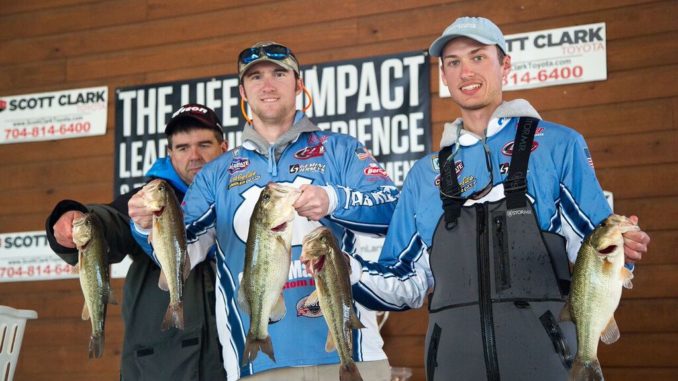
Matching the hatch helps
With wintertime setting in, dedicated bass anglers know that the lakes across both Carolinas can offer some of the best bass fishing of the year. And it’s some of the most peaceful fishing too, with very few pleasure boaters, skiers, or personal watercraft on the water.
But bass fishing is about more than having a peaceful time. So how do you get these fish to bite in cold weather? While different anglers will give you different answers, one method used by John Bitner, a member of the UNC Chapel Hill Bass Fishing Team, is to go deep with Alabama rigs rigged with small curly tail grubs or small swimbaits.
Bitner primarily uses this technique on Belews Lake this time of year, but anglers at other lakes across the Carolinas can find similar success, as long as those lakes have baitfish like shad, and as long as the lakes have some relative depth.
For Bitner, the key is locating the schooling baitfish, then to keep his Alabama rig running above the bass.
“The bass at Belews key in on baitfish and often school up in the deep, clear water. What I like to do is idle through the creeks at the south end of the lake and points, watching my depth finder for bait balls or clusters of fish. If I see what looks like a school of bass or large clusters of shad, these are the areas I stop and fish,” he said.
And while he sticks mainly with grubs in the 3-inch range, he said anglers should pay attention to the size of baitfish in their particular lake to determine what they should use.
“As far as baits go, I like to use 3-inch curly tail grubs or small 3 to 4-inch swimbaits in pearl white colors. I prefer these smaller baits to best match the hatch at Belews, which has mainly smaller shad,” he said.
Bitner said no matter what depth he finds the bass, his goal is to keep his lure running slightly above them.
“These fish are usually not near the top of the water column, but are typically suspended between 10 and 30 feet below the surface. I look at my depth finder on 2D sonar and take note of where the fish or bait is suspended in the water column. The goat is to keep the Alabama rig running above the bass. They will come up from 10 to 20 feet below to strike at the rig in Belews’ clear water,” he said.
Trying different rates of retrieve is always a good idea, and Bitner usually settles on a slow to medium retrieve, but isn’t afraid to modify that based on how the fish are reacting. And when it all comes together, it can make for a full day of catching bass.
“I like to use a slow to medium speed constant retrieve, but often mix it up with different speeds and pauses to see what gets bit the most. If you get a school that is active, you can catch them for hours on this setup,” he said.




Be the first to comment